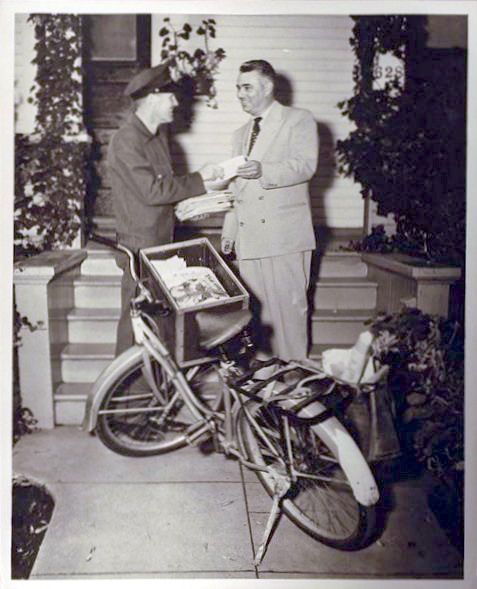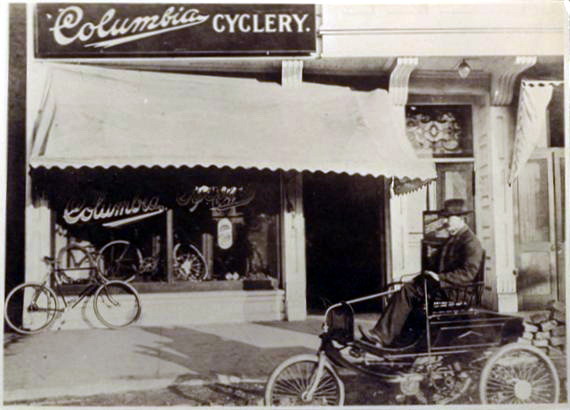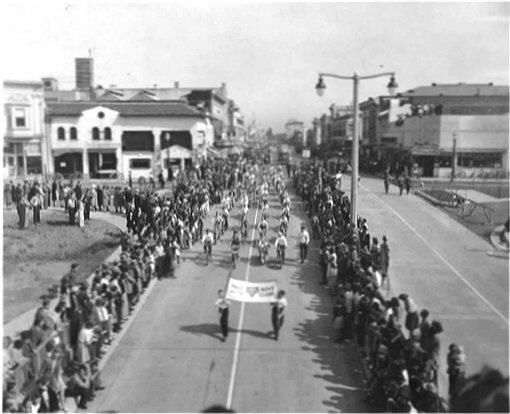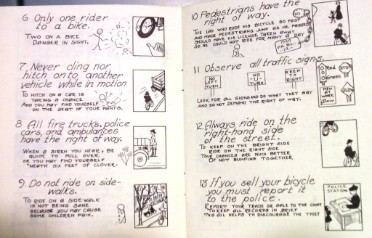Bikes in Palo Alto: A Ride Through History
There is a reminiscent scene that takes place in Palo Alto each afternoon that seems to belong more in the 1950s than present day. Waiting at the light at Newell and Embarcadero any weekday around 3 p.m., you’ll see a crossing guard stop the busy flow of cars in favor of a swarm of kids biking home from Jordan Middle School. It’s been a similar sight for decades as boys and girls trade jokes and gossip while balancing books, lunch bags and backpacks on their ride home to the neighborhood. Still, despite this visual throwback, bicycles are not as central to this generation. There was a time when the bicycle was more important in the life of a Palo Alto child than a TV, Xbox, or cell phone is today. For kids of that earlier era, the bicycle meant freedom.
Childhood memories of those who grew up in Palo Alto often revolve around the bicycle. Up through the '40s, '50s and '60s, bikes were indispensable to kids from the time the training wheels came off until they got their first driver’s license. It was a different era — a time of independence and innocence in which parents were not in the business of shuttling their children from “playdates” to soccer practice and back home again.
The bike offered school-age riders a sense of freedom — a chance to explore their surroundings, visit friends and, of course, get into mischief. Combing through the memories of grown-up Palo Altans on the local Town Square Forum, virtually every recollection of the halcyon days of youth is related to a bicycle. Forum posters remember “Riding bikes down the dry creek beds,” “Riding our bikes to the 'drive-up' window at Berkeley Farms for snow-cones,” and “Riding bikes down Louis Road to get fudge bars at Piers Dairy.” One poster memorably describes “Sneaking across Middlefield on our bikes to buy candy and gum at Fran's on Lytton Street. I remember my little brother, Perry, and his friends constantly getting in trouble for playing in the creek. The evidence was usually poison oak rashes and/or yet another lost bike.”
In those days, parents were not seen as derelict in allowing their kids to roam the neighborhoods on their bikes. Perhaps there was less danger or perhaps those dangers just weren’t so publicized. Either way, kids had more space back then. One Palo Altan remembered “Riding bikes all over town without parents knowing where we were — no problem.” Another recalled, “Riding bikes and skateboards all over town all summer and no one worried,” while a third recollected “Never fearing anything and always feeling safe and secure riding our bikes and playing on a warm summer evening.”
Not that the hordes of kids on bikes in town didn’t present a few problems. The old Palo Alto papers are full of stories of city higher-ups trying to deal with kids and bikes. For instance, youngsters going to the movies had a habit of just throwing their bikes into piles on the city sidewalk. Of course, this troubled the window shoppers on University Avenue who had a tendency to trip over them. It seemed shop owners were in a constant losing battle to keep their front entrances clear of stray bikes. In 1947, police chief Howard Zink caused his share of grief enforcing an ordinance that prohibited obstruction of the sidewalk by bicycles. After impounding 22 bikes on the first day, Zink was besieged with kids at Police Court with “tearful and vociferous protests” according to the Palo Alto Times.
It was similar scene in the 1950s when the council tried to enforce license plates on the city’s estimated 13,000 bikes. A license could be had by passing a short test and paying a dollar. This measure was in response to the remarkable amount of bicycles being stolen — some 80 bikes in a single month in 1948. It seems that for many kids, bikes were virtually communal property. Someone took your bike last week, maybe you borrow one this week. There were also attempts to educate young riders to be more aware of traffic laws, although such efforts could sometimes come across as a bit heavy-handed. One 1941 city pamphlet for young bike riders begins with the statement that “Riding a bicycle on the streets and highways is a privilege granted us by the city and state free of charge.”
Bike contests and parades were also popular in Palo Alto both before and after the war. For instance, a 1940 Bicycle Day at Rinconada Park included “three-way relays, obstacle races, stunts, and elegant prizes for riders with decorated bicycles.” There was a “Cycle Trade of America Silver Cup Trophy” to shoot for and a plank ride in which boys and girls tried to ride their bikes across a wooden plank that was 150 feet long, five inches wide, and one inch thick. One year, a youngster named Eddie Hill made it all the way across three times in a row.
In Palo Alto’s earliest days, however, bike contests weren’t just for the kids. In the late 1880s, the modern bicycle was invented and those high-wheeled penny-farthings were put in the back of the garage. The new faster, safer bikes soon produced bicycle clubs all across the country. On the Peninsula, biking was near fanatical. As proof, look no farther than the popular “Century Race,” a 100-mile, ten-hour jaunt from San Jose, up the East Bay, across a ferry and back down the Peninsula. Fanaticism went a bit too far during one San Jose race when a rival club member shot biker Emil Agraz in the ankle with seven miles to go — somehow Emil still managed to win his group.
Indeed, San Jose was biking central as the famed Garden City Wheelmen and other top clubs turned out Olympic riders and national cycling champion Otto Zeilger Jr., known as “The Little Demon.” Later San Jose became the first and last city in the United States to own its own velodrome, a cycling-only stadium. But young Palo Alto was also home to a rather devoted group of cyclists with competitive teams such as the Mayfield Wheelmen and the Palo Alto Cycle Club in town. A further highlight each year was the “businessman’s invitation race” in which local merchants competed. The Palo Alto Times reported in 1895 on one such Saturday morning contest. The finish was described with great pizzazz. Lumberman, bank president and future mayor J.F. Parkinson “came down the avenue amid great shouts and turned the corner onto Alma Street with a sweep that nearly took their breath away and caused a cloud of dust to follow…like that which follows the flyer. Parkinson was in the lead pulling out for the win, his light coat fanning the breeze like a mizzen sail.” Clearly if the so-called “Father of Palo Alto” could ride like that, bicycles and the city would long be linked.
And indeed they have been. Now more than a century later, Palo Alto’s longtime fondness for the bicycle remains. The city’s friendly attitude toward cyclists is still evident in its 30 miles of bike lanes, the Bryant Street Bicycle Boulevard (the nation’s first such enterprise) and the popular bike trails to be carved out of the Palo Alto Baylands. So while kids today may not ride all over town like previous generations, Palo Alto has not lost its love for what the old-timers simply called "The Wheel." It seems it has been in our blood ever since old Mr. Parkinson set out in his cloud of dust.

A Palo Alto mailman delivers a letter via bicycle. (PAHA)

Fred Smith posing outside his Columbia Cyclery on University Avenue. (PAHA)


An army of boys in bikes at the 1941 Dedication Day Parade.
My Bicycle Book promoted safety among Palo Alto youth.